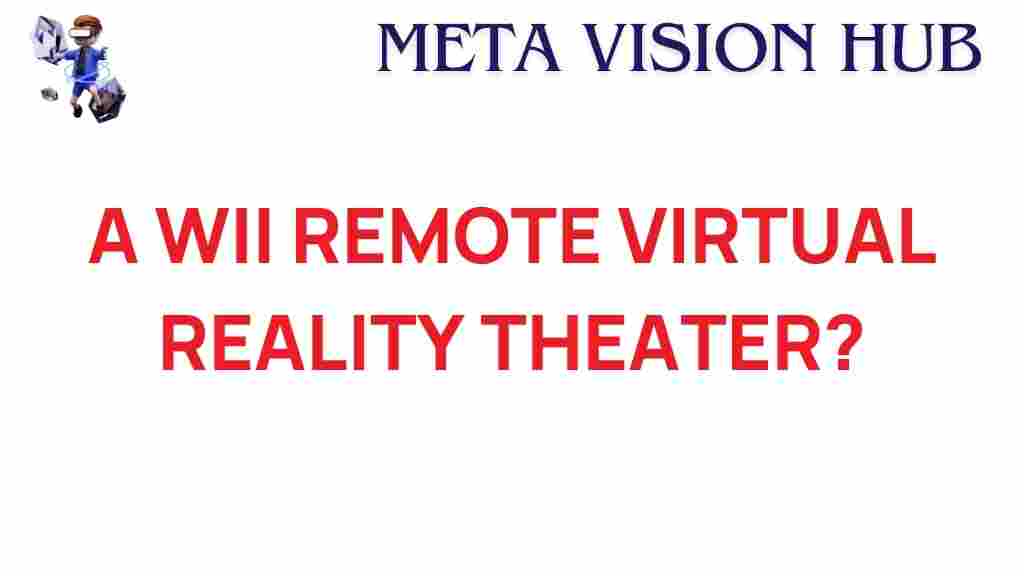The Wii Remote in Virtual Reality Theater
The Wii Remote, Nintendo’s iconic motion-sensing controller, has found a surprising new application in the realm of virtual reality (VR) theater. With its advanced motion tracking and innovative design, the Wii Remote offers a unique opportunity for performers and audiences to interact with digital environments in unprecedented ways.
In this article, we’ll explore how the Wii Remote is revolutionizing VR theater, guiding you through its integration, benefits, and troubleshooting tips. Whether you’re a VR enthusiast or a theater practitioner, understanding this technology opens up exciting new possibilities.
Understanding the Wii Remote’s Capabilities
Originally developed for the Nintendo Wii console, the Wii Remote features cutting-edge motion-sensing technology, including an accelerometer, infrared detection, and Bluetooth connectivity. These features make it a versatile tool beyond gaming, particularly in VR theater.
Key Features of the Wii Remote
- Motion Sensing: Detects orientation and acceleration in 3D space.
- Infrared Tracking: Enables precise pointing and interaction with virtual objects.
- Bluetooth Connectivity: Ensures compatibility with a wide range of devices.
- Ergonomic Design: Comfortable for extended use by performers and audience members.
Integrating the Wii Remote into Virtual Reality Theater
Integrating the Wii Remote into VR theater requires a combination of software and hardware tools. Here’s a step-by-step guide:
Step 1: Setting Up the Wii Remote
First, ensure your Wii Remote is fully functional. Check the batteries, clean the sensor bar, and confirm the controller pairs correctly with your device.
Step 2: Connecting to a VR System
- Use Bluetooth to connect the Wii Remote to your VR-capable computer or console.
- Install third-party software like GlovePIE or Dolphin Emulator to map the Wii Remote’s buttons and motion sensors to VR commands.
Step 3: Syncing with VR Content
Integrate the Wii Remote with VR content using compatible engines like Unity or Unreal Engine. These platforms support custom input configurations, allowing you to tailor the controller’s functionality to your performance needs.
Benefits of Using the Wii Remote in VR Theater
The Wii Remote brings several advantages to virtual reality theater, enhancing both production quality and audience engagement:
- Affordability: Compared to dedicated VR controllers, Wii Remotes are cost-effective.
- Versatility: Supports various interactions, from simple gestures to complex movements.
- Immersion: Engages audiences with interactive storytelling and dynamic performances.
- Accessibility: Easy to set up and use for performers of all skill levels.
Troubleshooting Common Issues
While the Wii Remote offers numerous benefits, users may encounter occasional issues. Here are solutions to some common problems:
Connection Issues
- Problem: Wii Remote fails to connect via Bluetooth.
- Solution: Restart your device, ensure Bluetooth is enabled, and reattempt pairing.
Tracking Errors
- Problem: Pointer drifts or loses accuracy.
- Solution: Reposition the sensor bar or recalibrate the controller.
Software Compatibility
- Problem: Third-party software doesn’t recognize the Wii Remote.
- Solution: Update the software or check for driver issues.
Future Prospects of the Wii Remote in VR Theater
As VR technology continues to evolve, the Wii Remote has the potential to remain a valuable tool in innovative theater productions. Developers and creators are already exploring ways to further enhance its integration, leveraging its unique features to push the boundaries of immersive storytelling.
For more insights on integrating innovative technologies into theater, check out our guide on emerging trends in performance arts.
Conclusion
The Wii Remote is more than a relic of gaming history—it’s a bridge to new artistic horizons. By incorporating this versatile controller into virtual reality theater, creators can craft dynamic, interactive experiences that captivate and inspire.
With its affordability, accessibility, and advanced motion-sensing capabilities, the Wii Remote has proven itself as an indispensable tool for innovators in the VR theater space. As technology advances, its role is only set to expand, making it a staple in the toolkit of forward-thinking theater professionals.
This article is in the category ImmersiveTech and created by MetaVisionHub Team
